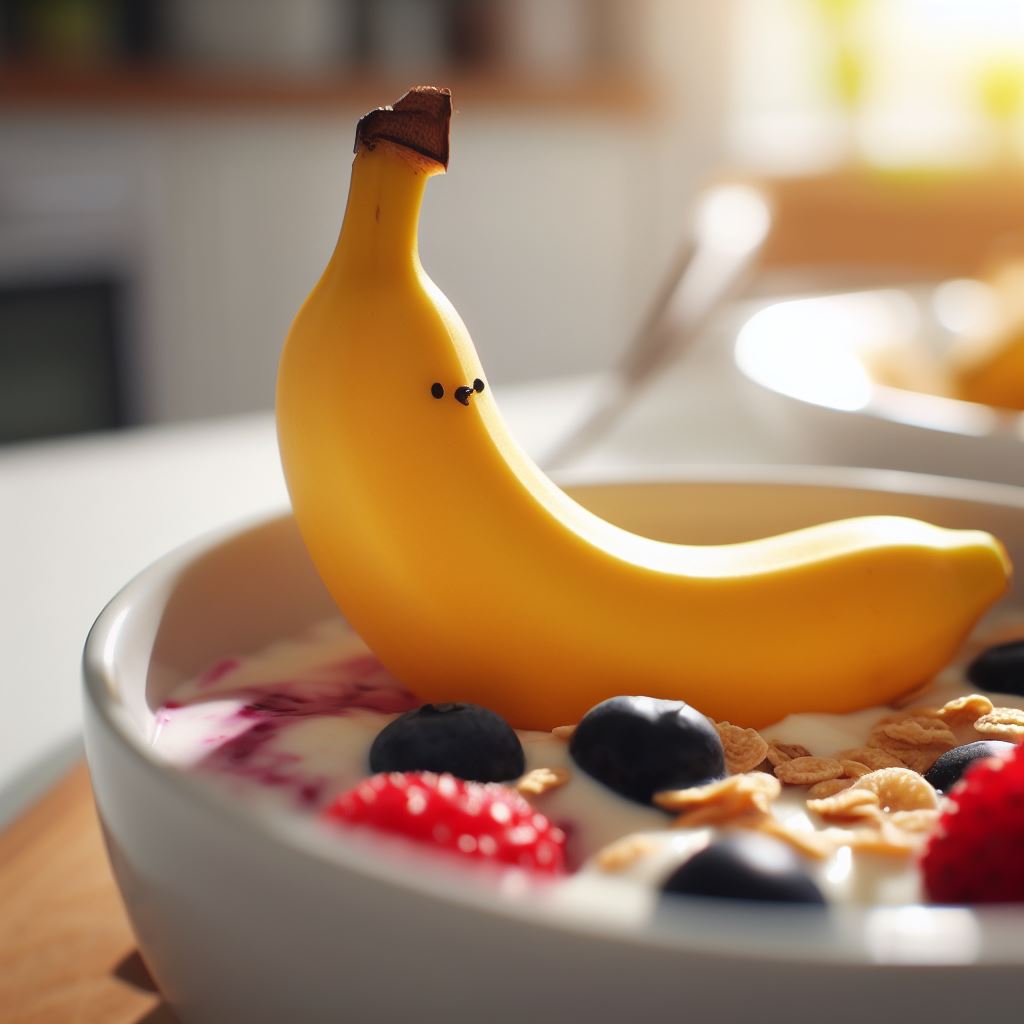Baby bananas, often referred to as “finger bananas” or “Lady Finger bananas,” are beloved for their petite size and exquisite sweetness. Harvesting and ripening these unique fruits require special care to unlock their full flavor and quality potential. In this comprehensive guide, we will take you through the intricate process of Harvesting and Ripening Baby Bananas, equipping you with the knowledge and skills needed to savor these miniature delights at their best.
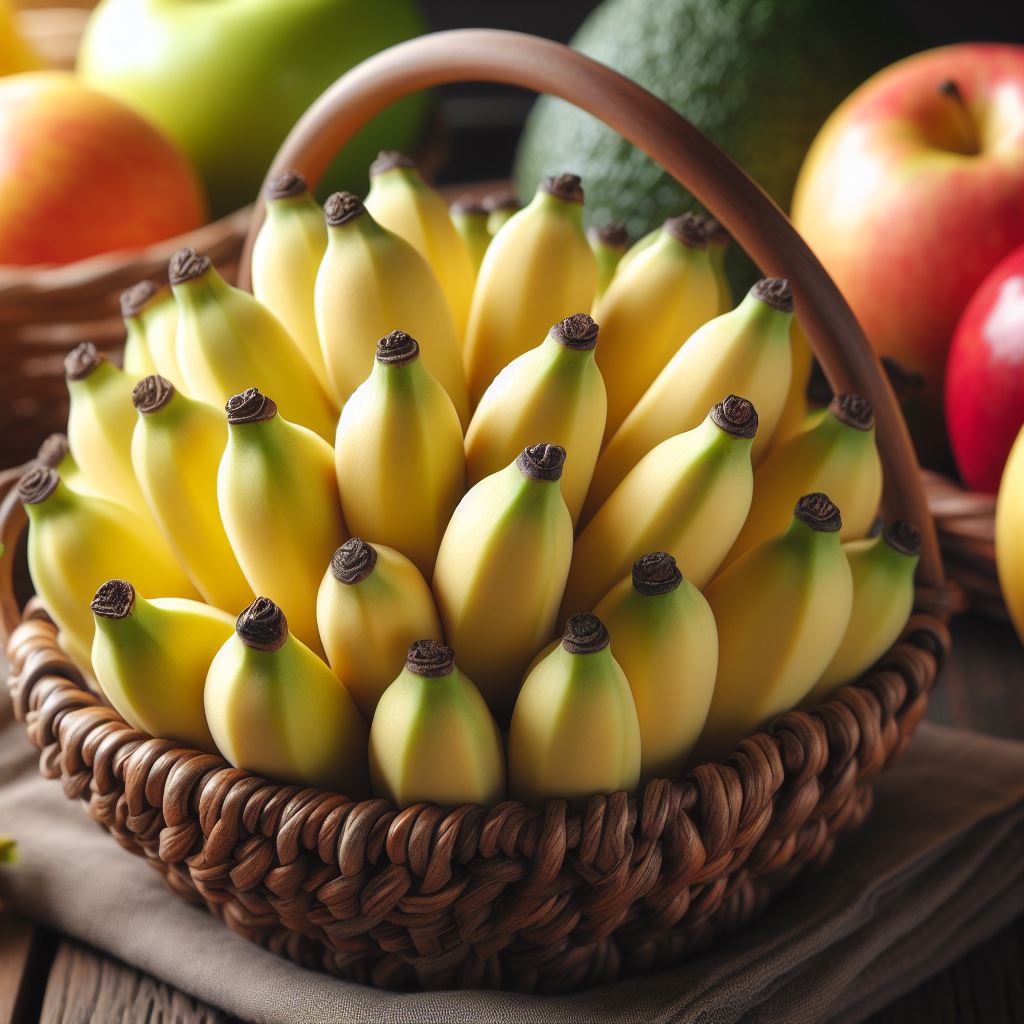
1. When to Harvest Baby Bananas
Table of Contents
Understanding the Optimal Harvest Time
Harvesting baby bananas at the right time is pivotal to relishing their exceptional flavor and quality. These miniature marvels, often referred to as “finger bananas” or “Lady Finger bananas,” have a unique sweetness and delicate texture that can be appreciated when harvested at the peak of ripeness.
The Ideal Stage for Harvesting
Baby bananas are best harvested when they are fully mature but not yet ripe. This is typically when they reach a length of about four to six inches and are firm to the touch. At this stage, they have developed their full flavor potential, and their color may have changed from green to a pale yellow or even a slightly creamy hue.
Avoiding Premature Harvest
It’s essential to avoid harvesting baby bananas when they are still entirely green or underdeveloped. Such premature harvest can lead to bananas with an unpleasant starchy taste and an unsatisfactory texture. Patience is key when it comes to baby banana harvesting.
Signs of Maturity
To determine if your baby bananas are ready for harvest, pay attention to the following signs of maturity:
- Size: The bananas should be approximately four to six inches in length.
- Color: They should exhibit a pale yellow to creamy color, indicating maturity.
- Texture: Baby bananas should be firm, not soft, when gently squeezed.
Ripe on the Plant
Unlike some larger banana varieties, baby bananas are typically not left to ripen on the plant. Instead, they are usually harvested while still green and firm, with the final ripening taking place after harvesting.
By adhering to these guidelines, you can ensure that your baby bananas are harvested at their prime, ready to be ripened and enjoyed to their fullest potential.
Expert Tips for Harvesting Baby Bananas
Harvesting baby bananas is a delicate process that requires careful attention to detail. Proper techniques and the right tools are essential to ensure a bountiful and undamaged yield. Let’s delve into the expert methods for harvesting baby bananas.
Essential Tools for Harvesting
Before you embark on the harvesting journey, make sure you have the following essential tools ready:
- Pruning Shears: A sharp pair of pruning shears is indispensable for cleanly cutting banana bunches from the plant.
- Gloves: Wear protective gloves to shield your hands from potential scratches and irritants, such as sap.
- Baskets or Bags: You’ll need containers to collect the harvested baby bananas. Baskets or bags with sufficient ventilation are recommended to prevent sweating, which can lead to spoilage.
Step-by-Step Harvesting
Follow these steps to harvest baby bananas with precision:
Step 1: Assess Maturity As mentioned earlier, determine the ideal stage of maturity by considering size, color, and texture.
Step 2: Position Yourself Stand in a comfortable position to access the banana bunch without straining.
Step 3: Pruning Use your pruning shears to cut the banana bunch cleanly from the plant, ensuring you leave a small portion of the stem attached to the bananas.
Step 4: Gently Lower Lower the harvested bunch carefully into your container to avoid damage. A sudden drop can cause bruising.
Step 5: Repeat Continue this process until you’ve harvested all the bunches you need.
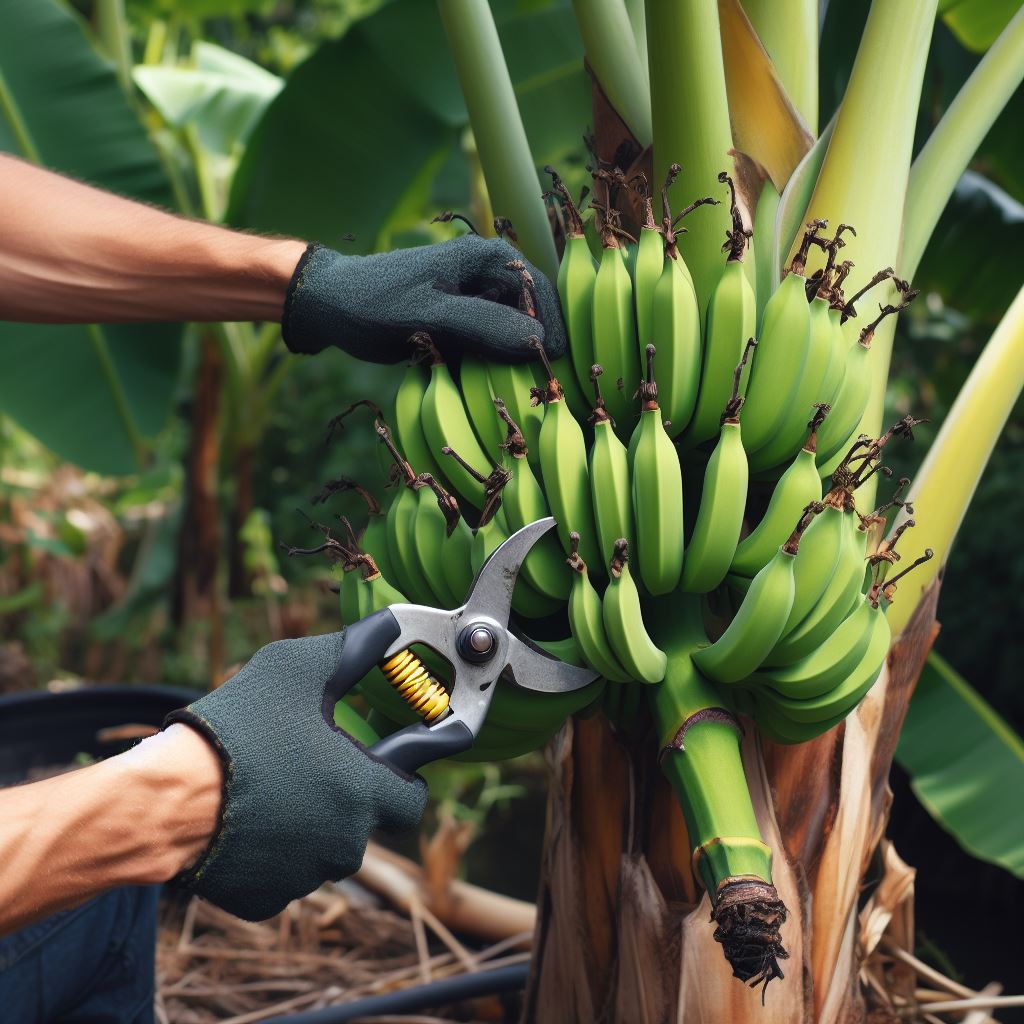
Avoid Overharvesting
It’s important not to overharvest your banana plant. Harvesting too many bunches at once can stress the plant and affect future yields. Leave some bunches on the plant to mature for subsequent harvests.
Proper harvesting techniques not only protect the quality of your baby bananas but also ensure the health and productivity of your banana plant for the long term.
3. Handling and Transport
Preserving Freshness: Tips for Handling and Transporting Baby Bananas
Once your precious baby bananas are harvested, their freshness largely depends on how well they are handled and transported. These tips will help you maintain the quality of your harvest from the field to your kitchen.
Gentle Handling
Use Clean Hands: Ensure your hands are clean and dry before handling baby bananas to prevent contamination and spoilage.
Avoid Bruising: Baby bananas are delicate. Handle them gently to prevent bruising, which can lead to rapid ripening.
Minimal Stacking: Avoid stacking bunches or placing heavy objects on top of them to prevent crushing.
Single Layer: If possible, arrange baby bananas in a single layer during transport to minimize pressure on the fruit.
Ventilation and Humidity
Ventilated Containers: Use baskets or bags with ventilation to allow air circulation, which helps prevent moisture buildup and mold.
Avoid Sweating: Be mindful of the humidity during transport, as baby bananas can “sweat” if exposed to excessive moisture, potentially leading to spoilage.
Proper Packaging: Ensure that baby bananas are packed securely but not overly tight to allow for air circulation.
Temperature Control
Optimal Temperature: Maintain a temperature of around 56°F (13°C) to slow down the ripening process and extend the shelf life.
Avoid Chilling: Do not store baby bananas in the refrigerator, as temperatures below 56°F can cause chilling injury, leading to a loss of flavor and texture.
Protection from Sunlight
Shade: When transporting baby bananas in open vehicles, provide shade to protect them from direct sunlight to prevent overheating and dehydration.
Quick Transport
Minimize Delays: Try to transport harvested baby bananas to your desired location as quickly as possible to prevent overripening.
By adhering to these guidelines for handling and transport, you can ensure that your baby bananas remain fresh and of the highest quality until they are ready for consumption.
4. Post-Harvest Care
Extending the Shelf Life of Baby Bananas
Post-harvest care is the key to ensuring that your baby bananas stay in peak condition and do not succumb to spoilage or rapid ripening. With the right care, you can extend their shelf life and enjoy their sweet flavor over an extended period.
Cleaning and Inspection
Gentle Washing: If your baby bananas have soil or debris on them, gently wash them under running water. Avoid soaking them, as excessive moisture can lead to spoilage.
Inspection: Examine each banana for signs of damage or bruising. Separate any damaged bananas to prevent them from affecting others.
Drying
Thorough Drying: After washing, ensure that the baby bananas are thoroughly dried. Excess moisture can lead to rot, so allow them to air dry before storage.
Storage
Proper Container: Transfer the baby bananas to a container suitable for storage, such as a fruit bowl or a banana hanger.
Room Temperature: Store the container at room temperature, away from direct sunlight and heat sources.
Ventilation: Ensure that the container allows for air circulation, which helps prevent moisture buildup.
Check Regularly: Periodically check your baby bananas for any signs of ripening or spoilage. Remove any affected bananas promptly to prevent them from affecting the others.
Ripening Timing
Patience is Key: Baby bananas typically continue to ripen after harvest. Be patient, and wait for them to reach your desired level of ripeness.
By following these post-harvest care practices, you can savor your baby bananas at their best for an extended period, ensuring that none go to waste.
5. Ripening Baby Bananas Naturally
Unlocking the Secrets of Natural Ripening
Ripening baby bananas naturally can be a rewarding experience, allowing you to enjoy their sweetness without the use of artificial methods. Natural ripening is not only simple but also eco-friendly.
The Ethylene Effect
Ethylene is a natural plant hormone produced by fruits as they ripen. It plays a significant role in the ripening process and can be harnessed to ripen baby bananas naturally.
Ethylene Producers
Some fruits are known for their ethylene-producing qualities, and they can be used to accelerate the ripening of baby bananas. Here are a few ethylene-producing fruits you can use:
- Apples: Apples are among the most effective ethylene producers. Place a ripe apple near your baby bananas to speed up the ripening process.
- Avocadoes: Ripe avocados release ethylene and can be used alongside baby bananas for natural ripening.
- Tomatoes: Mature tomatoes also emit ethylene and can be placed with baby bananas to facilitate ripening.
The Paper Bag Method
The paper bag method is a classic way to harness ethylene for natural ripening. Here’s how to do it:
Select Ethylene Producers: Choose one or more ethylene-producing fruits from the list above.
Place Baby Bananas: Put your baby bananas in a paper bag. You can group them by bunches or individual bananas.
Add Ethylene Producers: Insert the chosen ethylene-producing fruits into the bag with the baby bananas.
Seal the Bag: Fold the top of the paper bag and seal it with a clip or tape to trap the ethylene gas.
Wait Patiently: Leave the bag undisturbed at room temperature and check regularly for ripeness.
Monitoring Ripeness
Baby bananas ripening through this method should be checked frequently. When they reach your desired level of ripeness, remove them from the bag and enjoy.
Natural ripening is not only eco-friendly but also allows you to savor the unique flavor and sweetness of baby bananas at your own pace.
6. Artificial Ripening Techniques
Delving into Artificial Ripening
Artificial ripening techniques are widely used to ensure a consistent supply of ripe bananas to the market. Understanding these methods is essential for those involved in the commercial banana industry and for individuals looking to enjoy perfectly ripened baby bananas on-demand.
Ethylene Gas
One of the most common artificial ripening methods involves the controlled use of ethylene gas. Ethylene is a natural plant hormone that triggers the ripening process.
Ripening Rooms
Ripening rooms or chambers are specially designed facilities where the concentration of ethylene gas, humidity, and temperature can be controlled to accelerate the ripening process. Here’s how it works:
- Preparation: Green baby bananas are placed in the ripening room.
- Ethylene Injection: Ethylene gas is introduced at controlled levels to initiate the ripening process.
- Monitoring: The environment in the ripening room is carefully monitored, including temperature and humidity, to ensure optimal ripening conditions.
- Ripening Duration: The ripening duration is determined by the desired level of ripeness.
Ethephon
In addition to ethylene gas, there are a few other artificial ripening methods that are used commercially. One method involves using a chemical called ethephon, which is applied to the bananas as a spray or dip. Another method involves exposing the bananas to warm air and high humidity.
Some people have expressed concerns about the safety of using artificial ripening methods, particularly the use of ethylene gas. Ethylene gas is a flammable gas that can be harmful to human health if inhaled in high concentrations. However, the amount of ethylene gas used to ripen bananas is very small, and it is quickly broken down by the fruit.
There are also some natural alternatives to artificial ripening methods. For example, ripe tomatoes and avocados produce ethylene gas, so they can be placed in a bag with unripe bananas to speed up the ripening process.
Calcium Carbide
Historically, calcium carbide was used for artificial ripening due to its ability to release acetylene gas, which functions similarly to ethylene. However, this method is less common today due to safety concerns and potential health risks associated with calcium carbide residues.
It’s important to note that in many countries, the use of calcium carbide for ripening is prohibited or strictly regulated due to safety and health concerns. Ethylene-based methods have largely replaced it.
Artificial ripening is a well-regulated process in the commercial banana industry, with strict adherence to safety standards to ensure the quality of ripened bananas and consumer health.
7. Ripeness Indicators
How to Tell When Baby Bananas Are Perfectly Ripe
Determining the ideal moment to enjoy your baby bananas at their peak flavor and texture can be a delightful endeavor. Here, we’ll explore the telltale signs and indicators of perfect ripeness.
Color
Baby bananas evolve from green to yellow as they ripen. The ideal stage for consumption is a pale yellow hue. Avoid eating them when they are entirely green, as they may have a starchy taste, and refrain from waiting until they turn overly ripe and brown, as their texture may become mushy.
Firmness
Gently squeeze a baby banana to assess its firmness. When perfectly ripe, it should yield slightly to pressure without being too soft. Overripe bananas become mushy, while unripe ones remain rock-hard.
Aroma
Ripe baby bananas emit a sweet, tropical fragrance. A subtle but inviting aroma is a clear indicator of their readiness for consumption. If they lack scent, they may still need some time to ripen.
Skin Texture
Inspect the skin of the baby banana. It should be free from major blemishes, bruises, or dark spots. Small brown speckles on the skin are normal and often indicate ripeness.
Taste Test
Ultimately, the best way to determine ripeness is through a taste test. When you believe a baby banana is ready, take a small bite. If it’s sweet and has the desired texture, it’s perfect. If not, give it a bit more time to ripen further.
By mastering these ripeness indicators, you’ll consistently enjoy your baby bananas at their best.
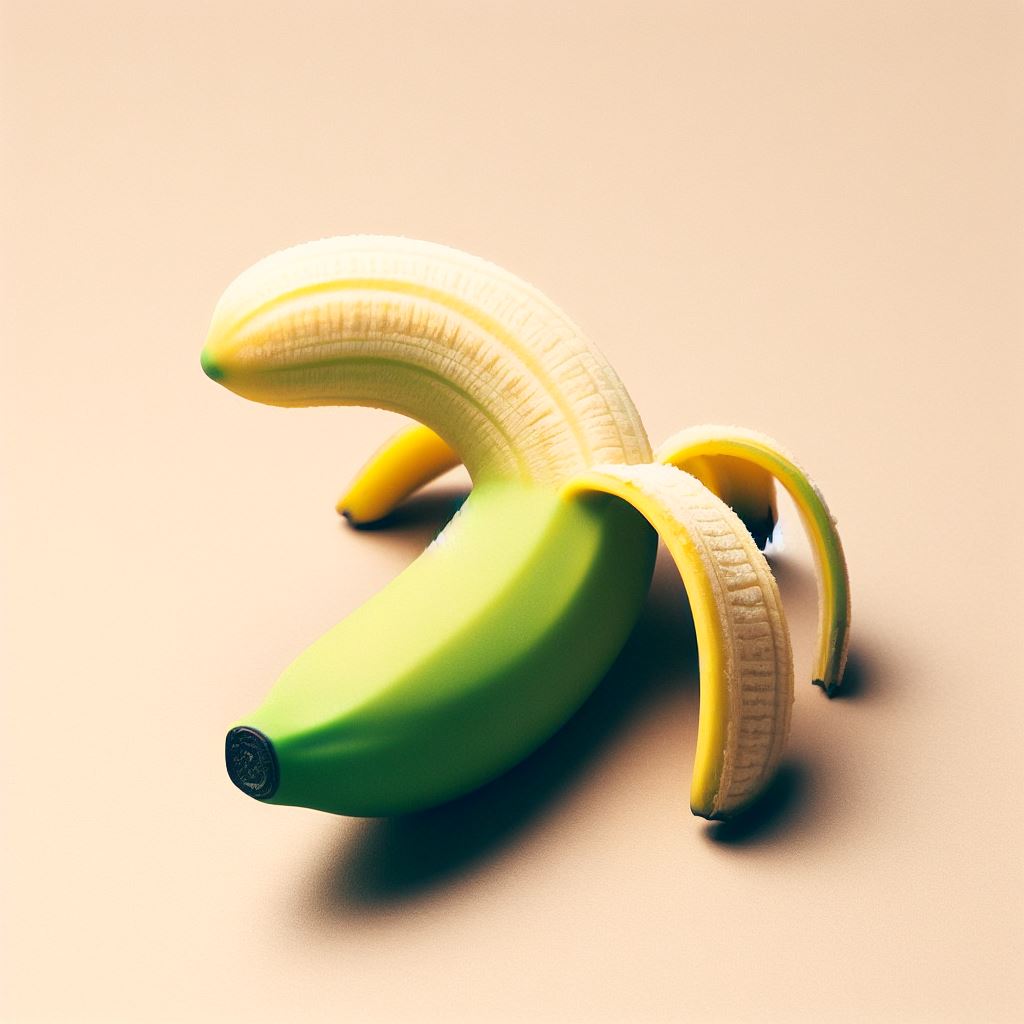
8. Storing Ripened Baby Bananas
Maintaining Freshness After Ripening
Once your baby bananas have reached the desired level of ripeness, proper storage is crucial to preserve their freshness. Follow these tips to ensure they stay delicious.
Storage Containers
Transfer your ripened baby bananas to a suitable storage container. Options include a fruit bowl, a hanging banana hook, or even a mesh bag. The container should allow for adequate air circulation.
Room Temperature
Store the container at room temperature in a cool, dry place, away from direct sunlight and heat sources. Placing them in the kitchen, away from the stove and appliances that emit heat, is ideal.
Separation
Ensure the baby bananas are not overcrowded in the storage container. Overcrowding can lead to bruising and rapid overripening. Give them some space to breathe.
Check Regularly
Periodically check your stored baby bananas for any signs of overripening or spoilage. Remove any affected bananas promptly to prevent them from affecting the others.
Separate Overripe Bananas
If you have bananas that have become overripe and won’t be consumed in time, consider peeling and freezing them for use in smoothies or baking. This prevents waste and allows you to enjoy their sweet flavor in other forms.
By implementing these storage practices, you can extend the shelf life of your ripened baby bananas and avoid unnecessary waste.
9. Speeding Up Ripening
Quick Methods to Ripen Green Baby Bananas
If you’re eager to enjoy your baby bananas but have a bunch that is still green, there are ways to expedite the ripening process. Here’s how to do it:
The Brown Paper Bag Trick
The brown paper bag method is a simple and effective way to concentrate the ethylene gas naturally produced by fruits like apples, avocados, or tomatoes. This gas accelerates the ripening of baby bananas.
- Place your green baby bananas in a brown paper bag.
- Add an ethylene-producing fruit such as a ripe apple or avocado.
- Seal the bag tightly, ensuring it’s closed to trap the ethylene gas.
- Leave the bag at room temperature and check regularly for ripeness.
This method can significantly reduce the time it takes for your green baby bananas to ripen and become sweet and ready for consumption.
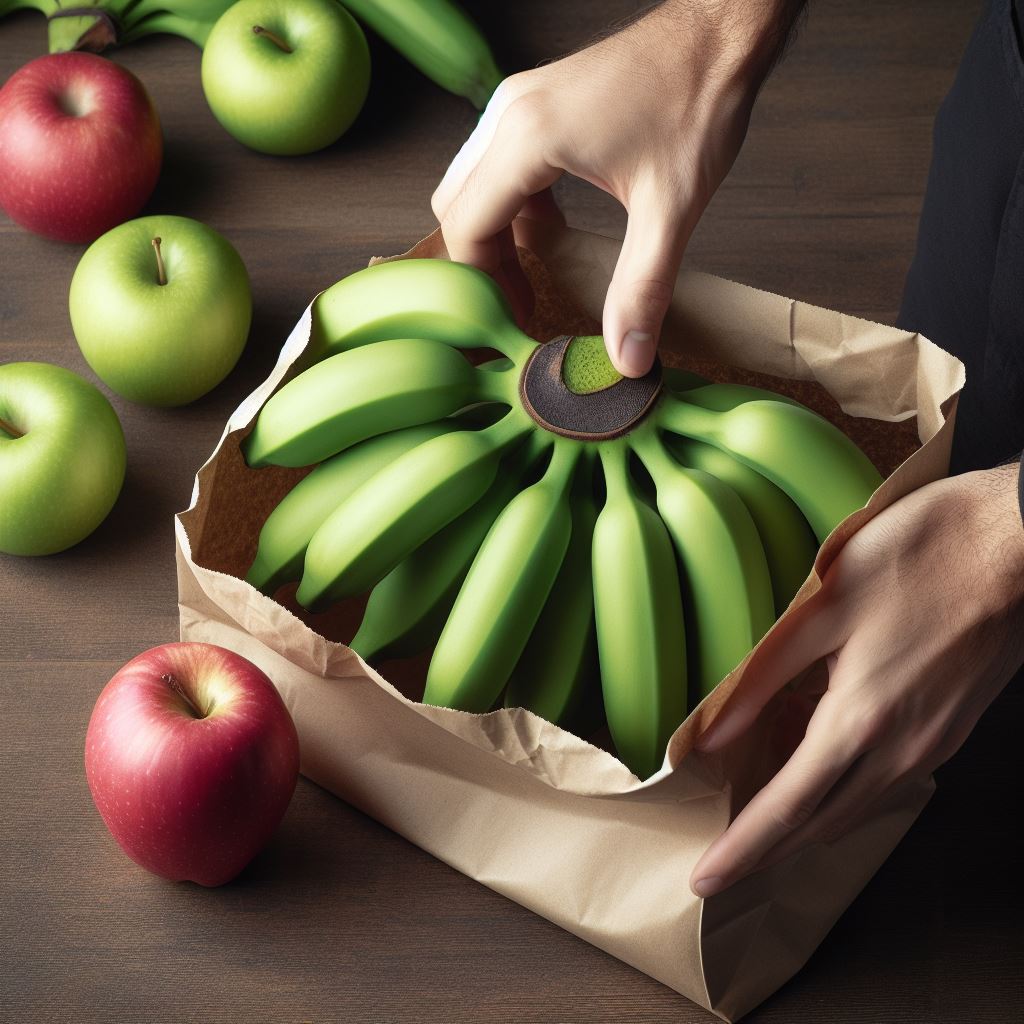
10. Ripening Challenges
Overcoming Common Ripening Issues
Ripening baby bananas can sometimes present challenges, especially when dealing with factors like temperature, humidity, and timing. Here are solutions to common ripening issues:
Uneven Ripening
If some of your baby bananas ripen faster than others, consider separating the ripe ones from the green ones. Store them in different containers to control their ripening pace.
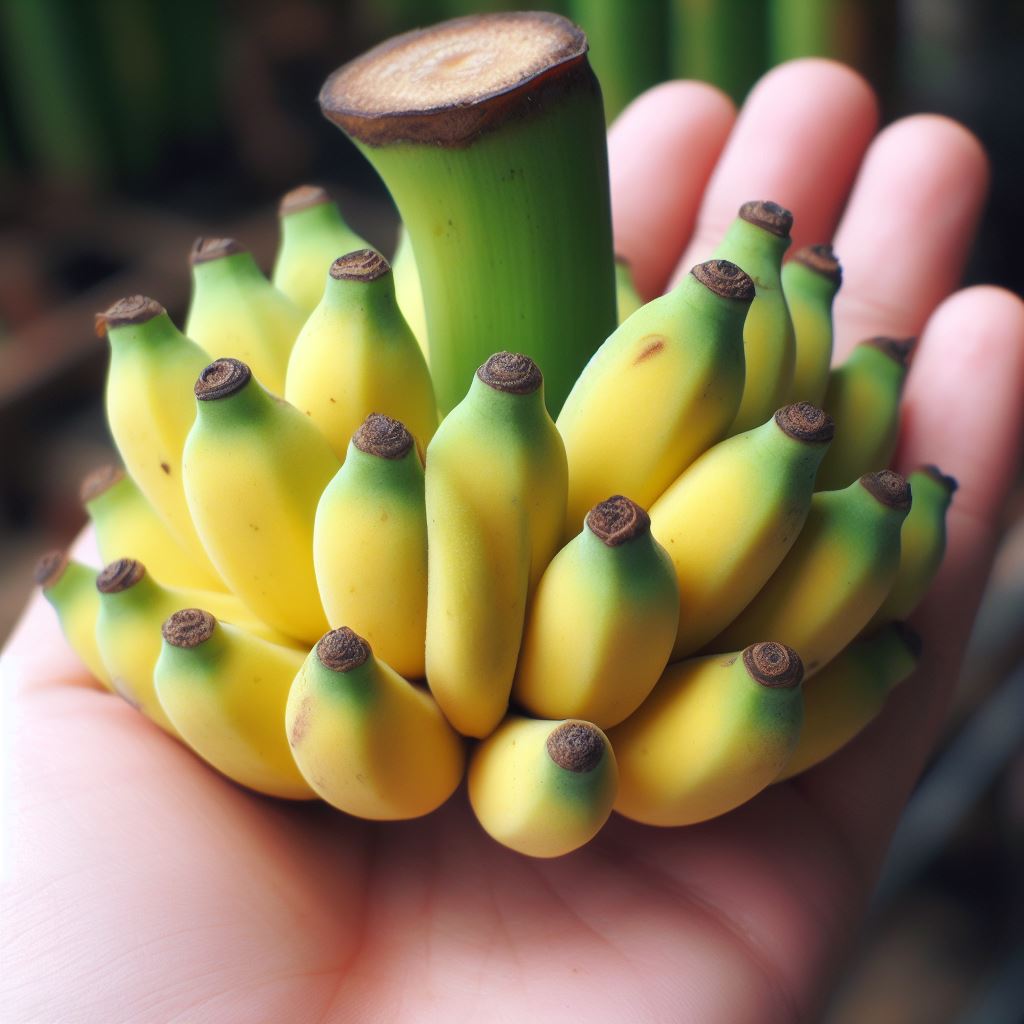
Overripening
To prevent overripening, regularly check your ripened baby bananas and remove any that have reached your desired level of ripeness. By segregating them, you can enjoy them at their best and avoid waste.
Chilling Injury
Baby bananas are sensitive to cold temperatures. If they’ve been exposed to temperatures below 56°F (13°C) and exhibit chilling injury, allow them to return to room temperature to recover their flavor and texture.
Mold Growth
Moisture and lack of ventilation can lead to mold growth on baby bananas. Ensure proper ventilation and humidity control during storage to prevent this issue.
By addressing these common challenges, you can enjoy your baby bananas without encountering unwelcome surprises during the ripening process.
11. Harvesting and Ripening Safety
Ensuring Safety During the Process
Safety is paramount during the harvesting and ripening of baby bananas. Consider the following tips to safeguard both harvesters and consumers:
Protective Gear
Harvesters should wear appropriate protective gear, including gloves and long sleeves, to minimize contact with potentially irritating plant substances and to protect against minor injuries.
Harvesting Tools
Use sharp, well-maintained harvesting tools, such as pruning shears, to ensure clean cuts and minimize the risk of accidents.
Proper Ventilation
If artificial ripening methods are used, ensure that ripening rooms or chambers are well-ventilated to prevent the accumulation of ethylene gas, which can be harmful in high concentrations.
Labeling
For businesses and commercial operations, label ripened baby bananas appropriately to indicate ripeness level and safety information for consumers.
Education
Proper training and education for workers involved in harvesting and ripening are essential to ensure that safety procedures are followed.
Compliance
Adhere to safety and health regulations related to the handling of ethylene gas and other substances used in artificial ripening.
Prioritizing safety in both the harvesting and ripening processes is essential for the well-being of those involved and the overall quality of the product.
12. Sustainable Harvesting Practices
Eco-Friendly Approaches to Baby Banana Harvesting and Ripening
As the world becomes more environmentally conscious, sustainable practices in agriculture are gaining importance. Discover eco-friendly methods for harvesting and ripening baby bananas that support sustainability.
Reduced Chemical Usage
Minimize the use of chemical pesticides and fertilizers to reduce the environmental impact of banana cultivation. Explore organic farming methods that prioritize natural pest control and soil health.
Efficient Water Management
Implement efficient water management practices to reduce water wastage during cultivation. Drip irrigation and rainwater harvesting are methods that conserve water resources.
Integrated Pest Management
Adopt integrated pest management strategies that involve the use of beneficial insects and natural predators to control pests, reducing the need for chemical pesticides.
Responsible Waste Management
Properly manage waste generated during harvesting and ripening processes. This includes the disposal of ethylene gas scrubbers and other waste materials in an environmentally responsible manner.
Biodiversity Conservation
Promote biodiversity by preserving natural habitats in and around banana plantations. Maintaining biodiversity can help control pests and protect local ecosystems.
Fair Labor Practices
Support fair labor practices by ensuring that workers involved in banana cultivation and ripening are treated ethically and paid fair wages.
Sustainable practices in the baby banana industry not only benefit the environment but also contribute to the long-term success of banana cultivation.
13. Harvesting and Ripening Baby Bananas for Commercial Use
Commercial Considerations
Harvesting and ripening baby bananas for commercial use involves specific techniques and considerations to meet consumer demand and deliver high-quality bananas to the market.
Uniform Ripeness
Commercial operations strive to provide consumers with uniform ripeness. This requires careful monitoring of the ripening process and sorting bananas based on their ripeness level.
Ethylene Ripening Rooms
Large-scale commercial operations often rely on ethylene ripening rooms to control the ripening process. These rooms are equipped with systems to manage temperature, humidity, and ethylene concentration.
Packaging
Baby bananas are typically packaged in bunches or clusters to offer convenience to consumers. Packaging should be designed to protect the fruit and maintain its quality.
Transportation
For commercial distribution, baby bananas are transported to various markets and retailers. Temperature-controlled transportation is crucial to prevent overripening or chilling injury.
Quality Control
Quality control measures are implemented to ensure that only premium baby bananas reach consumers. This includes sorting, grading, and inspecting the fruit for size, appearance, and ripeness.
Commercial harvesting and ripening of baby bananas involve a combination of precision, technology, and quality assurance to meet the demands of a diverse and discerning consumer market.
14. Regional Variations
Diverse Approaches to Harvesting and Ripening
Different regions and cultures have their unique methods and traditions when it comes to harvesting and ripening baby bananas. Let’s explore some regional variations:
Tropical Regions
In tropical regions where baby bananas are native, they are often harvested and ripened using traditional methods. The warm climate and natural ethylene producers like mangoes and papayas facilitate natural ripening.
Commercial Plantations
Commercial plantations in various countries, such as Ecuador and the Philippines, have adopted advanced techniques for harvesting and ripening to meet global demand.
Cultural Practices
In some regions, baby bananas are incorporated into cultural practices and traditional celebrations. Special rituals and festivals may revolve around the harvest and ripening of these delightful fruits.
Unique Varieties
Different regions may cultivate their unique varieties of baby bananas with distinct flavors and characteristics, influencing the ripening process.
Exploring these regional variations adds a rich cultural dimension to the fascinating world of baby banana harvesting and ripening.
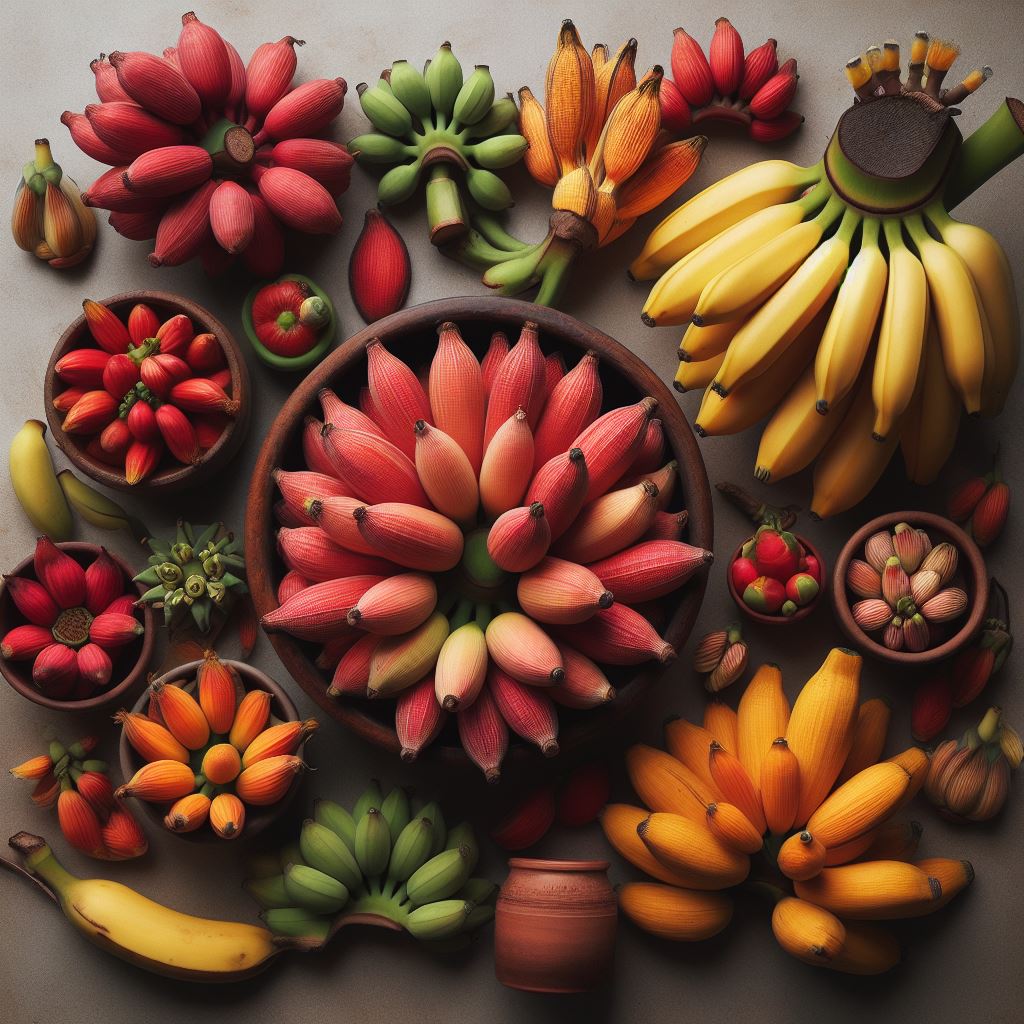
15. Recipes and Culinary Uses
Creative Culinary Ideas for Perfectly Ripened Baby Bananas
Perfectly ripened baby bananas are a versatile ingredient that can elevate your culinary creations. Here are some creative recipes and culinary uses to inspire your kitchen adventures:
Baby Banana Smoothies
Blend ripe baby bananas with yogurt, a splash of milk, and your favorite fruits for a delicious and nutritious smoothie.

Baby Banana Pancakes
Add mashed baby bananas to your pancake batter for a delightful twist on traditional pancakes. Serve with maple syrup and fresh berries.
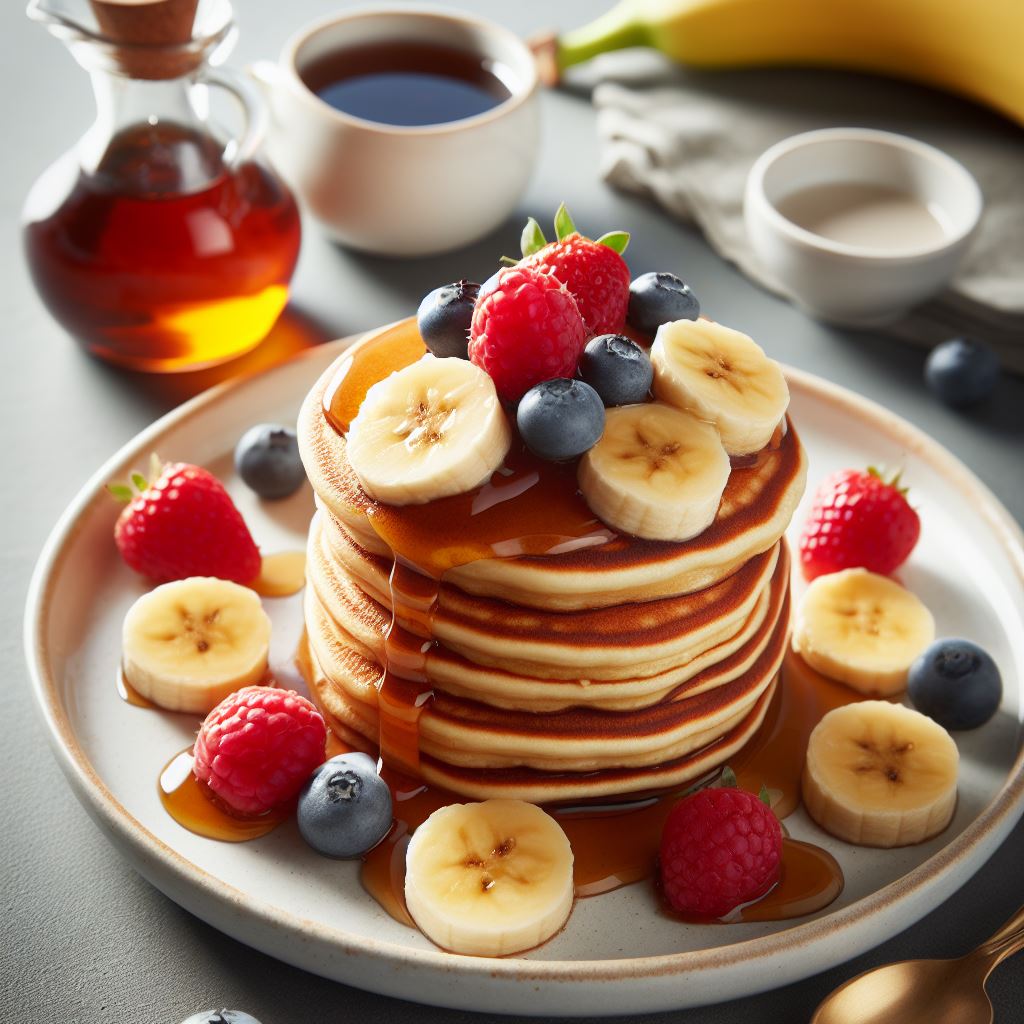
Baby Banana Sorbet
Puree ripe baby bananas with a touch of lemon juice and honey, then freeze for a refreshing and dairy-free dessert.
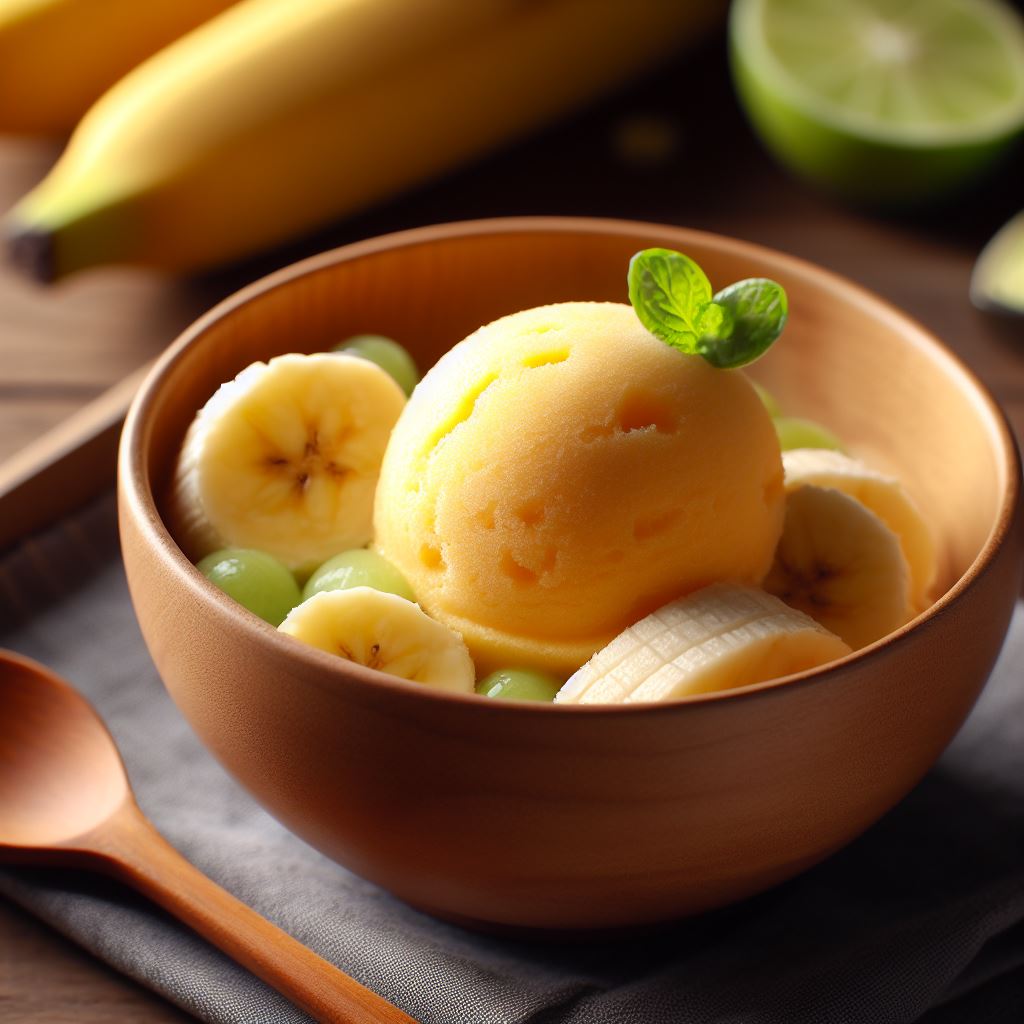
Baby Banana Muffins
Incorporate chopped baby bananas into your muffin batter for a moist and flavorful treat. Sprinkle with oats for a delightful crunch.
Baby Banana Salsas
Combine diced baby bananas with tomatoes, red onion, cilantro, and a hint of lime juice for a unique and tropical salsa.
Baby Banana Pudding
Layer vanilla wafers, vanilla pudding, and sliced baby bananas to create a classic banana pudding with a delightful twist.
Baby Banana Bread
Ripe baby bananas make a moist and delectable banana bread. Add chocolate chips or nuts for extra flavor.

Baby Banana Ice Cream
Blend frozen baby bananas for a dairy-free and naturally sweet ice cream. Customize with your favorite toppings.
Baby Banana Smoothie Bowl
Top a baby banana smoothie with granola, fresh fruits, and a drizzle of honey for a healthy and satisfying breakfast or dessert.
Baby Banana Oatmeal
Stir mashed baby bananas into your morning oatmeal for a creamy and naturally sweet kickstart to your day.
Experiment with these recipes and create your culinary masterpieces using perfectly ripened baby bananas as your star ingredient.
Conclusion
Understanding the nuances of harvesting and ripening baby bananas is a journey filled with appreciation for the fruit’s uniqueness and the diverse methods employed around the world. Whether you’re a home gardener, a passionate cook, or part of a commercial operation, the proper handling and ripening of baby bananas can lead to the sweetest rewards.
By recognizing the indicators of ripeness, embracing sustainable practices, and exploring regional variations and culinary possibilities, you can fully appreciate the charm and versatility of these tiny treasures. Baby bananas are not only a delight to eat but also a symbol of the rich tapestry of human culture.
Enjoy the sweet journey of cultivating, harvesting, and ripening these miniature wonders, and savor the rich flavors they bring to your table.
Frequently Asked Questions (FAQs)
1. How long does it take for baby bananas to ripen naturally?
The time it takes for baby bananas to ripen naturally can vary depending on factors like temperature and humidity. On average, it may take a few days to a week for them to become fully ripe.
2. What tools are essential for harvesting baby bananas?
Essential tools for harvesting baby bananas include pruning shears, gloves, and baskets or bags for collecting the harvested bananas.
3. Can I use brown paper bags to speed up the ripening process?
Yes, brown paper bags can be used to speed up the ripening process of baby bananas when combined with ethylene-producing fruits. Place the bananas and the ethylene producers in the bag, seal it, and wait for them to ripen.
4. What are the challenges faced in commercial baby banana ripening?
In commercial ripening, ensuring consistency and controlling factors like temperature and humidity are essential. Meeting quality standards and complying with safety regulations are also significant challenges.
5. What is the ideal temperature for storing ripened baby bananas?
The ideal temperature for storing ripened baby bananas is around 56°F (13°C). Storing them at this temperature helps prolong their shelf life.
6. Are there any cultural rituals related to baby banana harvesting?
Yes, in some regions, baby banana harvesting is associated with cultural rituals and traditions. These can vary widely, so it’s important to research and respect local customs.
7. What are some innovative baby banana recipes for desserts?
Innovative baby banana recipes include banana muffins, banana ice cream, and banana tarts. These recipes make use of perfectly ripe baby bananas to create delicious desserts.
8. How can I prevent overripening during transport?
Prevent overripening during transport by ensuring proper handling, maintaining appropriate temperature and humidity, and avoiding prolonged exposure to direct sunlight.
9. Do baby bananas have any specific health benefits when perfectly ripe?
Perfectly ripe baby bananas are a good source of essential nutrients, including potassium, vitamin C, and dietary fiber. They can contribute to overall health and well-being.
10. What is the environmental impact of baby banana production?
The environmental impact of baby banana production varies by region and cultivation practices. Sustainable farming methods can help reduce the environmental footprint, while practices like monoculture and excessive pesticide use can have negative consequences.
11. Can I use a refrigerator to ripen baby bananas more slowly?
No, it’s not recommended to ripen baby bananas in the refrigerator. Temperatures below 56°F (13°C) can lead to chilling injury, affecting their flavor and texture.
12. What is the difference between baby bananas and regular-sized bananas?
Baby bananas, such as the Lady Finger variety, are smaller, sweeter, and have a more delicate texture compared to regular-sized bananas like Cavendish or Gros Michel.
13. Can I use ethylene gas for natural ripening at home?
Yes, you can use ethylene-producing fruits like apples, avocados, and tomatoes to facilitate natural ripening at home.
14. Are there any safety concerns with artificial ripening methods?
The use of calcium carbide for artificial ripening is associated with safety and health risks and is regulated or prohibited in many countries. Ethylene-based methods are safer and widely used in commercial settings.
15. Are there any specific pests or diseases that affect baby banana plants during cultivation?
Common pests and diseases that can affect baby banana plants include aphids, nematodes, and Panama disease. Implementing good agricultural practices can help manage these issues.
16. How do I store unripe baby bananas until they’re ready for consumption?
Store unripe baby bananas at room temperature and keep them away from direct sunlight. Place them in a location with good air circulation and monitor them for ripening.
17. What is the significance of sustainability in baby banana cultivation?
Sustainability in baby banana cultivation helps protect the environment, maintain soil health, and support the livelihoods of those involved in the banana industry. It also ensures a steady supply of this delightful fruit.
18. Can I use ripened baby bananas in savory dishes, or are they mainly for desserts?
Ripened baby bananas can be used in both sweet and savory dishes. They add a touch of natural sweetness to various recipes, including curries and chutneys.
19. Are there any baby banana varieties that are resistant to common diseases?
Yes, some baby banana varieties have been bred to be disease-resistant. Resistant varieties are a result of scientific breeding programs that aim to protect banana crops from diseases like Panama disease.
20. How can I find rare or exotic baby banana varieties to grow in my garden?
Rare or exotic baby banana varieties can often be found through specialized nurseries, online plant shops, or by connecting with fellow banana enthusiasts. Additionally, consider exploring local botanical gardens or horticultural events for unique cultivars.

